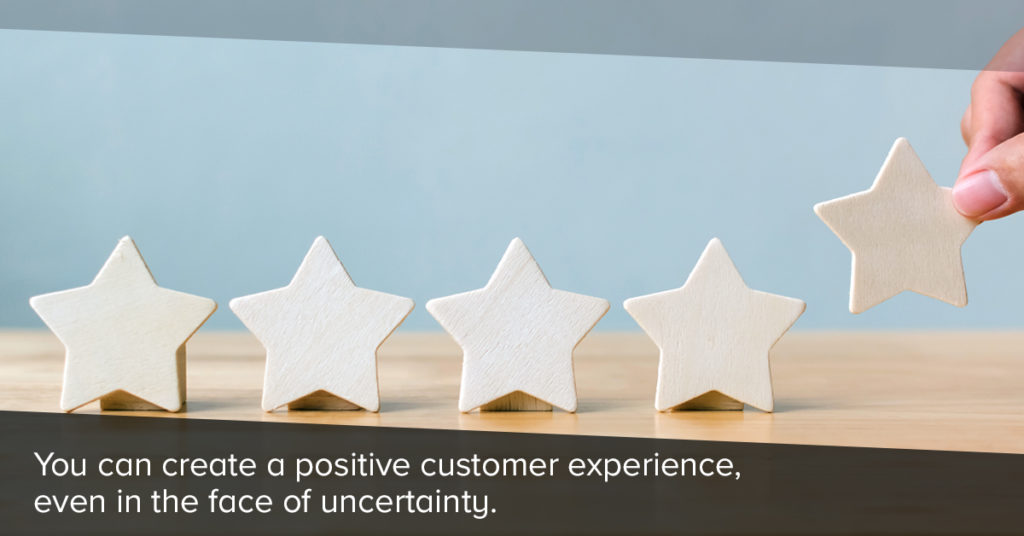
In a crisis, you can gain clarity with a CX mindset.
Customer experience (CX) is the linchpin to make-or-break business success. But in a crisis, what you know about your company’s CX is in flux, whether you planned for it or not. With a CX-centered mindset, you can create internal clarity, take care of your customers and strengthen your brand. There are tangible actions you can take today to improve and even redefine your customer experience to ensure it is contributing positively to your business.
3 Steps to Redefine and Improve CX
Ready to dive in? Here are the steps we’ll take you through:
- Understand the new normal
- Understand the leader mindset – including your own
- Understand your customers’ and employees’ evolving mindsets
1. Understand the new normal
The core of customer experience has always been empathy. But in the current climate, empathy has become another marketing buzzword. It can be hard to be empathetic when your customers may not even know how they feel. In times of crisis, even more so than other times, a customer’s interaction with a company triggers immediate and lingering effects on their sense of trust and loyalty. Actions and words that satisfy the average customer’s needs can leave important questions unanswered for others. As a result, organizations are challenging themselves on what it means to be agile, flexible and creative – and some are finding they come up short.
The solution? We need to think systematically about what this crisis means, not just react with new tactics. The fundamentals of engagement have changed and we have to look at everything with fresh eyes and without bias. There is power in awareness by itself, which is the first step in doing things differently. But for any meaningful change to take place, it has to start from within. You need to recognize the new, ever-shifting landscape and adapt your customer experience approach with courage and zero assumptions. Freeing your team from the clarity of the past will help them embrace the uncertainty of the new normal.
2. Understand the leader mindset – including your own
Research has shown that our ability to deal with a crisis is heavily dependent on our perception of it and consequently, our reaction to it. The saying “We can’t control the wind, but we can adjust our sails” applies now more than ever. Business leaders need to be aware of their cognitive biases to ensure sound decision-making and future competitiveness.
Mapping these changes into smaller chunks and clearly identifying what can be controlled is a first step to getting back into the driver’s seat. But that’s not all – executives need to continually check their activities and decisions against rapidly changing realities that emerge as the crisis progresses. The exercise of dynamic mapping can help leaders create a complete and sound basis for the decision making that captures the current situation, and potential future scenarios without falling into the traps of avoidance or short-term focus.
Dig Into Your CX Toolbox
⬥ Revisit journey maps and personas to identify and assess relevancy and questions that need answering about your customers.
⬥ Develop verification research. Are there new tactics or new approaches – such as relying on social listening and deconstruction of what’s being shared for sentiment rather than directly?
⬥ Do a pulse check on employee understanding.
⬥ Audit messaging and engagements to avoid tone-deaf, templated approaches.
3. Understand customers’ and employees’ evolving mindsets
Marketers and others struggle during a crisis like the COVID-19 pandemic. But when situations change rapidly and emotions run high, it can be a struggle to know what to say to your customers. One solution is to leverage your existing personas and journey maps. For each persona, ask a simple question: What are their situations and concerns right now, compared to even a couple of months ago? Once you understand the diversity of your customers’ needs, you can begin to consider the actions and information your organization can provide to satisfy those needs.
It is a fact that if your employees aren’t engaged at work and in your business, your customer experience will suffer. And now, your employees have new concerns about their health and livelihoods. With employees, the previous “knowns” may no longer be relevant as well. So having a flexible cadence of employee engagement outreach – brief, periodic surveys, doubling down on recognition and intentional, open and positive communications will help you understand the pulse of employee mindset and morale.
It’s important to recognize that what these tools were built on likely have shifted – and shifted rapidly. In times of global uncertainty, businesses can’t take anything as “known” anymore, so you have to re-evaluate how to set up your systems to be more flexible than ever. Leaders have to ask the hard questions and do the work to understand what’s different and what’s the same. The goal is to identify the full range of your customer and employee needs – and the information and support that you can provide to meet the most expectations. Doing this is a way to effectively shift from communication that merely expresses concern to actions and messaging that deliver solutions to customers and employees in need.
Wrap-Up
During a crisis, there are still tangible actions you can take to improve and even redefine your customer experience. In crisis mode, decisions made the day before – or even just hours ago – may have to be adapted in the face of new circumstances. Recognizing and adapting to the new normal, understanding yourself as a leader and being closely connected to your evolving customers and employees provide the foundation for a positive customer experience, even in the face of uncertainty and an ever-changing environment.
If you’re seeking to revisit and redefine your customer experience, contact Lexico.
